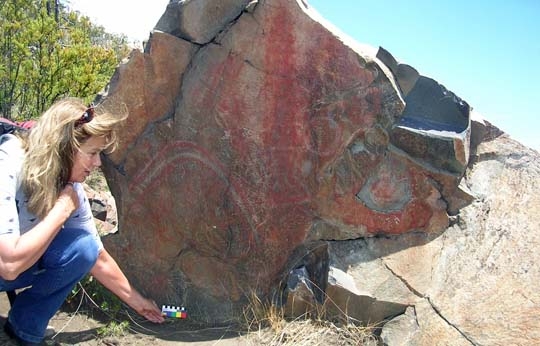SCIENTIFIC PROMOTION
CONICET professionals participated in a programme to preserve cave paintings
The Lago Epuyén archaeological site, in the province of Chubut, was vandalized three years ago.
Together with her team, Cristina Bellelli, CONICET independent researcher at the Instituto Nacional de Antropología y Pensamiento Latinoamericano (Ministerio de Cultura de la Nación) [National Institute of Anthropology and Latin American Thought, National Ministry of Culture], was in charge of the implementation of a management plan for the archaeological site Lago Epuyén. The plan was requested by the Municipality of Chubut and included protection and administration measures for public use.
The study was framed within several projects financed and approved by the CONICET, the University of Buenos Aires, the National Agency for Science and Technology Promotion of the Ministry of Science, Technology and Productive Innovation of Argentina, and the support of the Instituto Nacional de Antropología y Pensamiento Latinoamericano [INAPL, National Institute of Anthropology and Latin American Thought] of the National Ministry of Culture.
The Lago Epuyén site, called Piedra Pintada by the locals, is an attractive place for tourism and salmon fishing. The site is within the Intangible natural reserve area of the Puerto Bonito City Park. This place is part of the Andean Region of Parallel 42º, a protected area located northwest to the province of Chubut.
The great number of visitors made a negative impact on the paintings. Some of the damage was caused by intentional scratches and graffiti, and in other cases holes were dug on the sediments at the base of the block, sediment that may contain archaeological evidence. Furthermore, the site is exposed to forest fires.
“These paintings are valuable because they are a testimony to the native peoples who produced them”, Bellelli highlights.
Together with her team of archaeologists and the director of Environment and Tourism of Epuyén, Patricia Riquelme, Bellelli developed a plan including interpretative posters with archaeological information and knowledge for conservation; the construction of a floor boarding opposite the block of the paintings so as to have a proper sight of them and to have a sort of barrier to prevent visitors from getting too close to the rock; a guestbook (which will also help to prevent graffiti); the implementation of a monitoring plan and the communication of actions among the different local actors.
“It is relevant to highlight that the results of the basic research are used by social sciences and humanities to develop tools used to not only to protect cultural heritage but also for tourism and recreation”, Bellelli comments. For 20 years, the researcher has worked on the region with tools for protection and management of archaeological sites with cave paintings in a region ranging from the south of Bariloche to the north of Esquel. Besides, the team conducted a study that included the way of living of the first residents of El Hoyo, in the province of Chubut, who have lived there for 1200 years.
“The aim was to implement a management measure to reduce the current impact on paintings and the damages caused by vandalism. We focused on the development of a programme suitable for other archaeological sites with organized tourist visits within the Protected Areas of the provinces and the city of Chubut”, Bellelli concludes.
- By Douglas Mac Donald.
- About the research
- Cristina Bellelli. CONICET independent researcher. INAPL.
- Mercedes Podestá. INAPL.
- Soledad Caracotche. Responsible for the archaeological heritage of the Management of National Parks of Patagonia.
